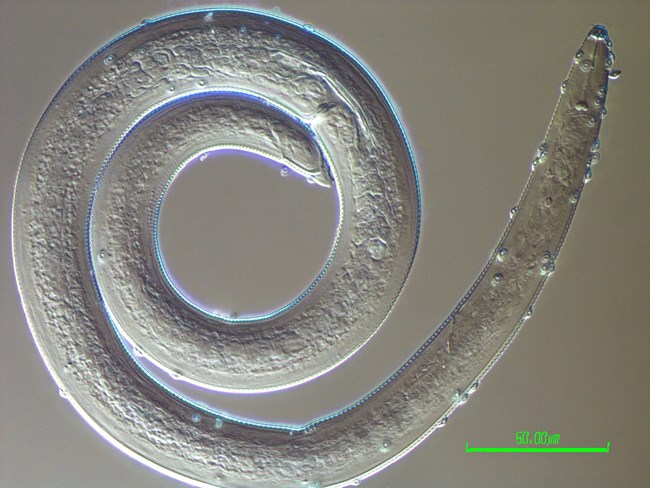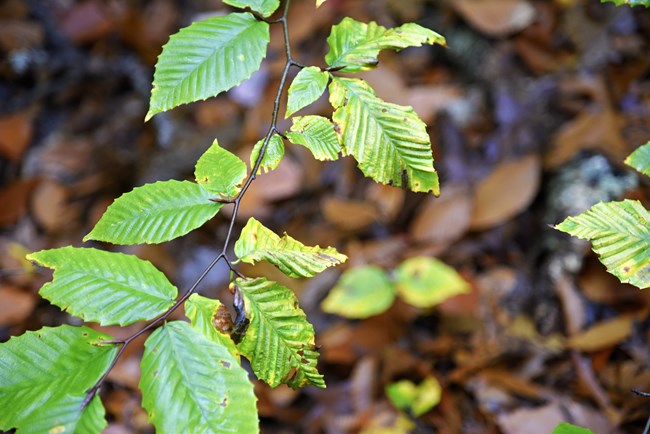Last updated: May 24, 2023
Article
Beech Leaf Disease at Cape Cod National Seashore

NPS Photo/Kristin Vinduska
Written by Kristin Vinduska, NPS
Cape Cod National Seashore is known for its vast coastlines with deep blue waves crashing upon shorelines that sweep up into golden cliffs and dunes. This dramatic picture is why most love visiting the seashore, to experience the salty air and look out with wonder at water as far as the eye can see. For those who have ventured into other parts of the National Seashore, they will know there are riches of unique landscapes to discover beyond the swirling sea and its shore. There are marshes, grasslands, ponds, and forests to explore on many miles of trails inside the National Seashore, with many finding the same sense of wonder in the plants that find a place to stretch out their roots across these landscapes. One of these places is the Beech Forest outside of Provincetown.
A forest of beech trees existing in this area is somewhat of an anomaly on its own. Typically, beeches need shelter from strong winds, access to water, and deeper soils. These are conditions not found often on the very end of the Outer Cape. The area where modern-day Provincetown is located was formed by ocean currents taking up sand from Cape Cod’s southern beaches and depositing it in long, parallel spits that stretch north into the ocean. Soil was created from the sediments that collected in the troughs that were between the spits. This rich soil is where beeches have been growing to a create the strong standing forest that has persevered through natural and man-made threats. These beeches were spared during the European colonists clear-cutting of the area, actions which created a desert-like landscape of eroding dunes with sparse poverty grass. As the wind rushed through the “desert” out on the Cape, the rustle of beech leaves could still be heard.
Beech trees are an important part of a forest ecosystem. Beech nuts produced by the trees have been a culturally important food source for Indigenous people traditionally associated with this area. They also are a part of the diet of many forest dwelling animals including black bears, deer, squirrels, and many kinds of birds. A beech forest can also provide shading for plants and other living creatures in its understory. A loss of the trees may cause changes in the canopy structure and species compositions. Finally, beech tree loss may result in a reduction or loss of important ecosystem services such as water filtration, biodiversity maintenance, carbon sequestration, and aesthetic, historic, and recreational value.
These beeches have survived the pounding of storm winds against their bark and stood brave against the echo of the colonist’s ax harvesting tree after tree. The Beech Forest is now being faced with a new challenge: beech leaf disease. First recorded in Ohio in 2012, beech leaf disease arrived with a shroud of mystery about where it came from and how it spreads. It is known, however, that many species of beech can be infected, including American Beech which is found in the Beech Forest.

Photo/Harold Grieb, United States Department of Agriculture
The juvenile and adult nematode associated with beech leaf disease migrates from leaves beginning in August to overwinter predominantly in buds and occasionally in leaf litter. In the spring when the beech buds break open, juvenile or adult nematodes are not found in symptomatic leaf tissues until late June or early July. However, the presence of the nematode has been confirmed by DNA-based evidence, presumably due to eggs. Nematode numbers increase through the fall. Then the cycle begins all over again, with more nematodes being spread through unknown pathways and beech trees continuing to be weakened. During certain times of year, beech leaves filled with nematodes can be seen under a microscope.
Beech leaf disease was noticed in the Beech Forest of Cape Cod National Seashore in 2021. It was confirmed by staff in 2022 while they were conducting forest monitoring surveys that are conducted on a five-year rotation. After this discovery, five additional forest monitoring plots were set up in the Beech Forest by park staff that will be monitored on a yearly basis. These monitoring areas are one-hundred-meter square plots that are broken up into four modules. Park staff work to identify the different species within these modules in order to estimate species cover. They will record tree density and diameter breast height, which shows tree growth from year to year. The disease has affected a large portion of the forest. Recent drought-filled summers and/or other environmental stresses may be making the beech more susceptible, contributing to their decline.

NPS Photo/Kristin Vinduska
While it is unknown what the future of beeches in the northeast looks like due to this disease, seashore staff think that the forest will be able to recover with native tree species replacing beech trees. While it is called the Beech Forest, the broader forested area is dominated by other tree species such as oak and pine. By gathering information on what species are growing in the Beech Forest understory, park staff can have a better idea of what might fill in the gaps left by the beech trees. Collecting data on beech tree density, including the number of seedings and saplings there are, will give a better picture of how much of the beech forest is affected by the disease year to year.
Although how the disease is spread or how long it takes for symptoms to develop has not been confirmed, it is thought to be possibly transported by birds due to the random and secluded nature of where the disease has shown up, including the Beech Forest. Beech leaf disease was discovered out on the end of Cape Cod before it had been detected anywhere else on the Cape. This area is a hub for many migratory birds that could have potentially carried the disease from somewhere else. In the local forest ecosystem, the disease could also be transported from tree to tree by other tree-dwelling animals and insects.
Seashore staff have been looking into treatments, but most would be difficult to employ due to the risk of impacting groundwater quality. Moreover, recovering trees could theoretically be re-infected. If some beeches are naturally resistant or tolerant of the disease, they could replace those that were susceptible. Researchers in Massachusetts and other affected states have established forest monitoring programs to investigate disease pathways and other treatment options. You can do your part by reporting beech leaf disease if you see the symptoms.

Symptoms can include:
- Dark bands between the veins of leaves
- Leaves are cupped, deformed, shriveled and may be smaller than usual
- Leaves can be thick and have a leathery texture, unlike the papery texture of healthy leaves
- Premature leaf drop
- Aborted buds leading to sparse leaf cover
- Thinning canopy
These symptoms can occur during different stages of infection. Find out more.
How to Report Beech Leaf Disease:
“If you think your beech tree might be infected with beech leaf disease, please report it to the DCR Forest Health Program by sending an email to Nicole.keleher@mass.gov or calling (857) 337-5173. Any details you are able to provide about the location, symptoms and severity of the disease, or any pictures of the tree will help us in our monitoring efforts of the progress of this disease in the Commonwealth.” (https://www.mass.gov/guides/beech-leaf-disease-in-massachusetts)
- Duration:
- 6.773 seconds
Sunbeams trickle through green beech leaves waving in the wind on a branch. Beech trees are an important part of a forest ecosystem. They provide important ecosystem services such as water filtration, food, biodiversity maintenance, carbon sequestration, and aesthetic, historic, and recreational value.
